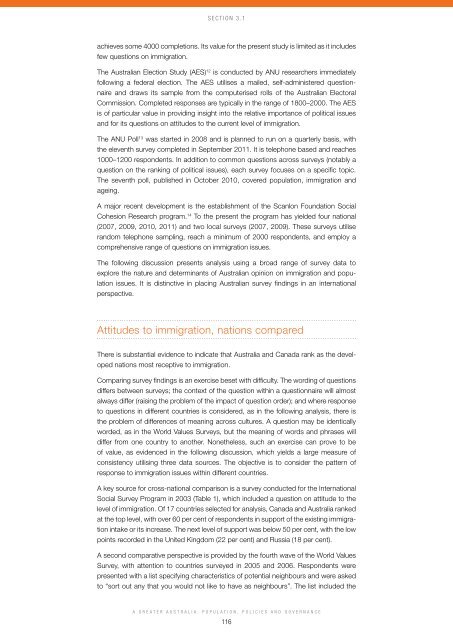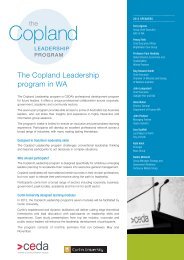A Greater Australia: Population, policies and governance - CEDA
A Greater Australia: Population, policies and governance - CEDA
A Greater Australia: Population, policies and governance - CEDA
- No tags were found...
You also want an ePaper? Increase the reach of your titles
YUMPU automatically turns print PDFs into web optimized ePapers that Google loves.
Section 3.1achieves some 4000 completions. Its value for the present study is limited as it includesfew questions on immigration.The <strong>Australia</strong>n Election Study (AES) 12 is conducted by ANU researchers immediatelyfollowing a federal election. The AES utilises a mailed, self-administered questionnaire<strong>and</strong> draws its sample from the computerised rolls of the <strong>Australia</strong>n ElectoralCommission. Completed responses are typically in the range of 1800–2000. The AESis of particular value in providing insight into the relative importance of political issues<strong>and</strong> for its questions on attitudes to the current level of immigration.The ANU Poll 13 was started in 2008 <strong>and</strong> is planned to run on a quarterly basis, withthe eleventh survey completed in September 2011. It is telephone based <strong>and</strong> reaches1000–1200 respondents. In addition to common questions across surveys (notably aquestion on the ranking of political issues), each survey focuses on a specific topic.The seventh poll, published in October 2010, covered population, immigration <strong>and</strong>ageing.A major recent development is the establishment of the Scanlon Foundation SocialCohesion Research program. 14 To the present the program has yielded four national(2007, 2009, 2010, 2011) <strong>and</strong> two local surveys (2007, 2009). These surveys utiliser<strong>and</strong>om telephone sampling, reach a minimum of 2000 respondents, <strong>and</strong> employ acomprehensive range of questions on immigration issues.The following discussion presents analysis using a broad range of survey data toexplore the nature <strong>and</strong> determinants of <strong>Australia</strong>n opinion on immigration <strong>and</strong> populationissues. It is distinctive in placing <strong>Australia</strong>n survey findings in an internationalperspective.Attitudes to immigration, nations comparedThere is substantial evidence to indicate that <strong>Australia</strong> <strong>and</strong> Canada rank as the developednations most receptive to immigration.Comparing survey findings is an exercise beset with difficulty. The wording of questionsdiffers between surveys; the context of the question within a questionnaire will almostalways differ (raising the problem of the impact of question order); <strong>and</strong> where responseto questions in different countries is considered, as in the following analysis, there isthe problem of differences of meaning across cultures. A question may be identicallyworded, as in the World Values Surveys, but the meaning of words <strong>and</strong> phrases willdiffer from one country to another. Nonetheless, such an exercise can prove to beof value, as evidenced in the following discussion, which yields a large measure ofconsistency utilising three data sources. The objective is to consider the pattern ofresponse to immigration issues within different countries.A key source for cross-national comparison is a survey conducted for the InternationalSocial Survey Program in 2003 (Table 1), which included a question on attitude to thelevel of immigration. Of 17 countries selected for analysis, Canada <strong>and</strong> <strong>Australia</strong> rankedat the top level, with over 60 per cent of respondents in support of the existing immigrationintake or its increase. The next level of support was below 50 per cent, with the lowpoints recorded in the United Kingdom (22 per cent) <strong>and</strong> Russia (18 per cent).A second comparative perspective is provided by the fourth wave of the World ValuesSurvey, with attention to countries surveyed in 2005 <strong>and</strong> 2006. Respondents werepresented with a list specifying characteristics of potential neighbours <strong>and</strong> were askedto “sort out any that you would not like to have as neighbours”. The list included theA <strong>Greater</strong> <strong>Australia</strong>: <strong>Population</strong>, Policies <strong>and</strong> Governance116





